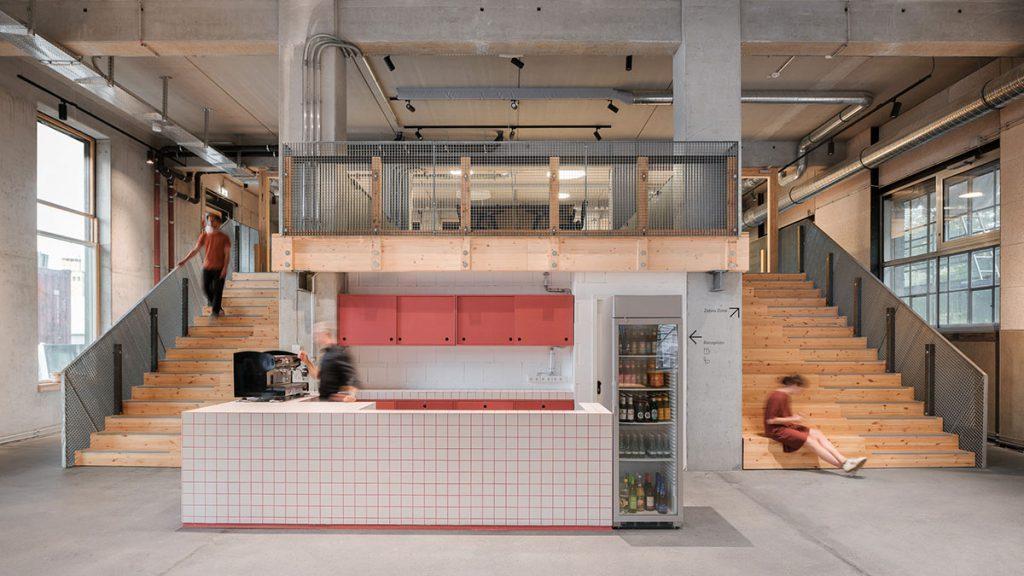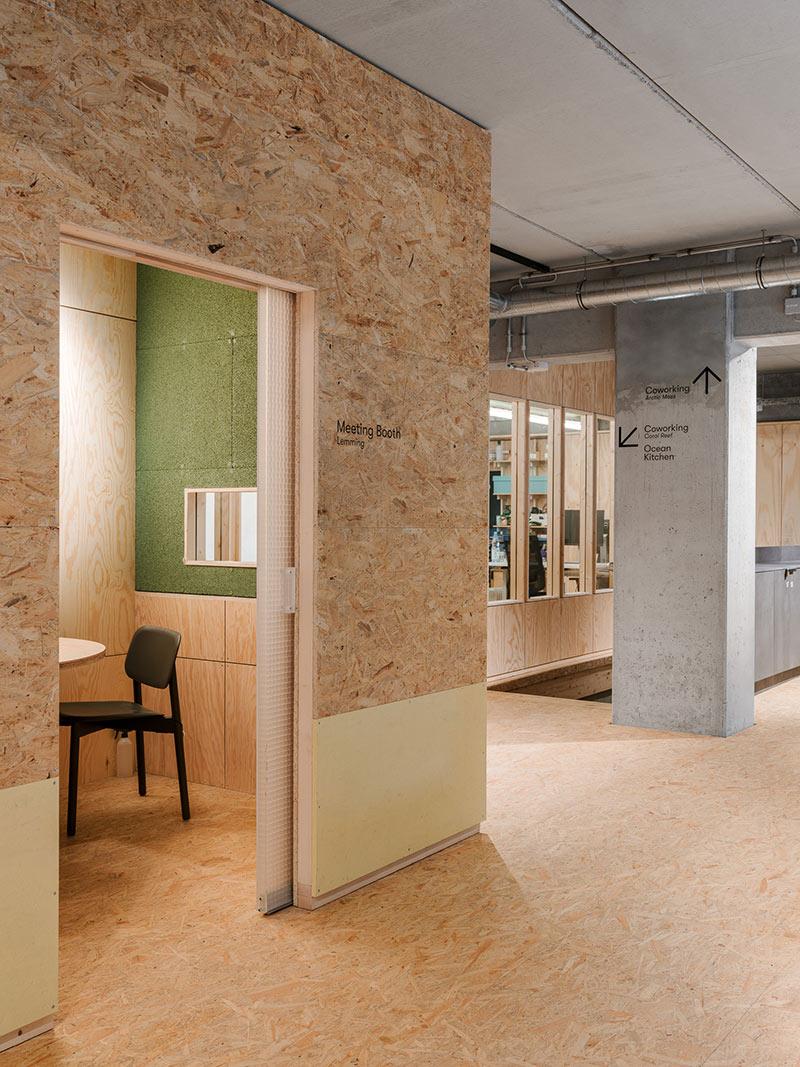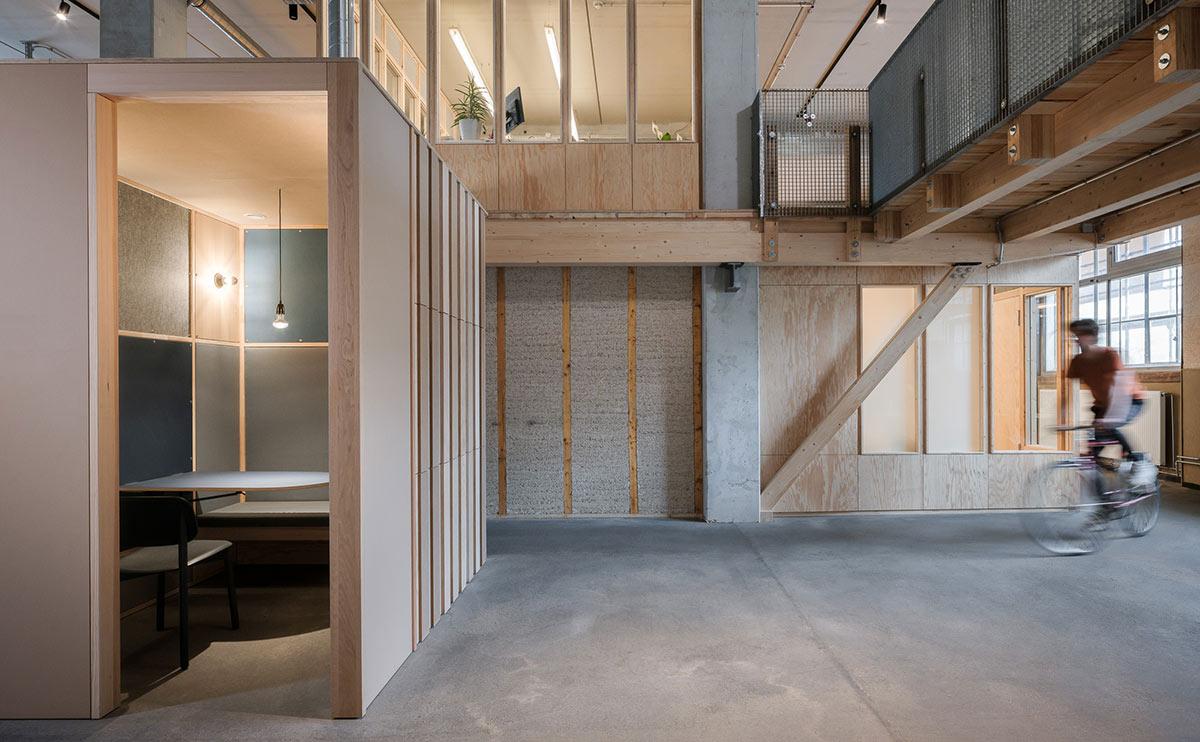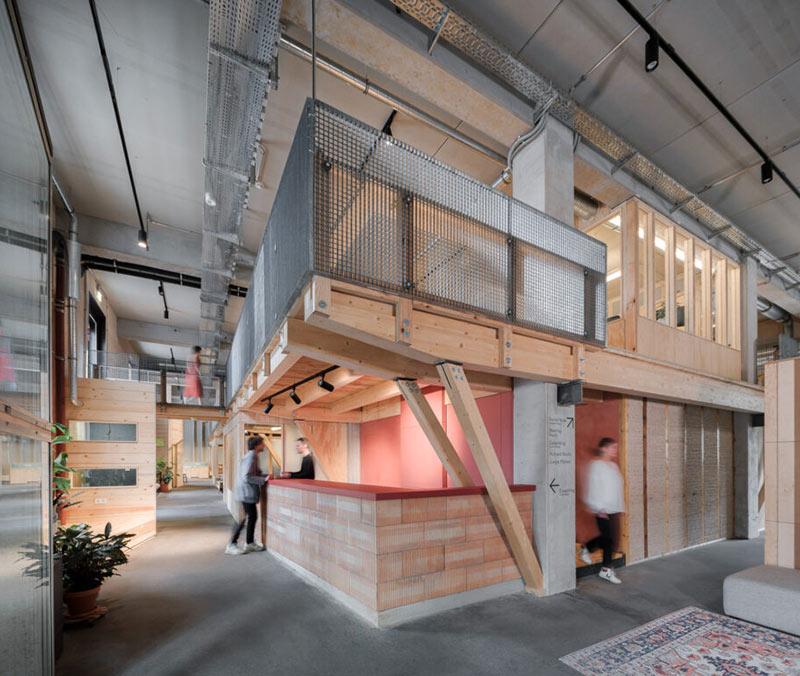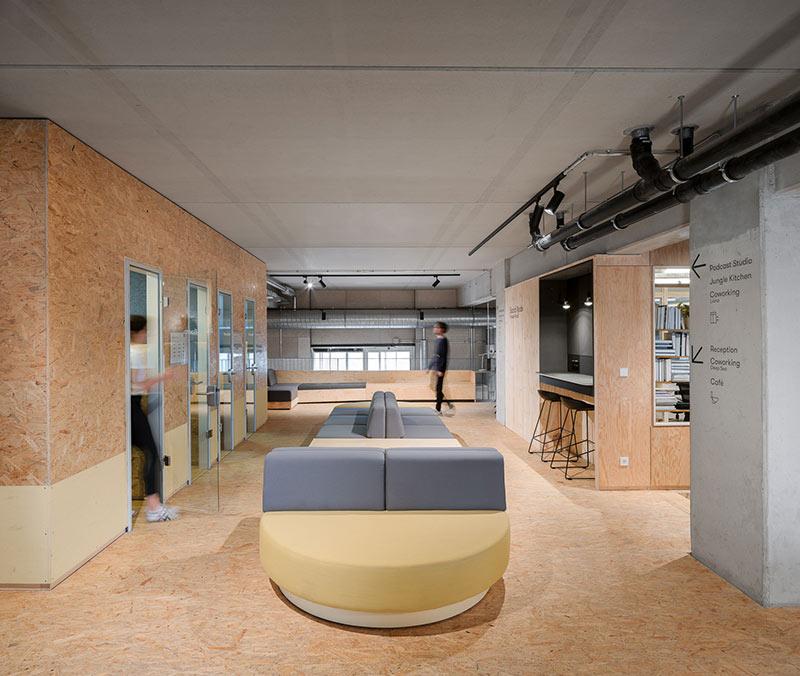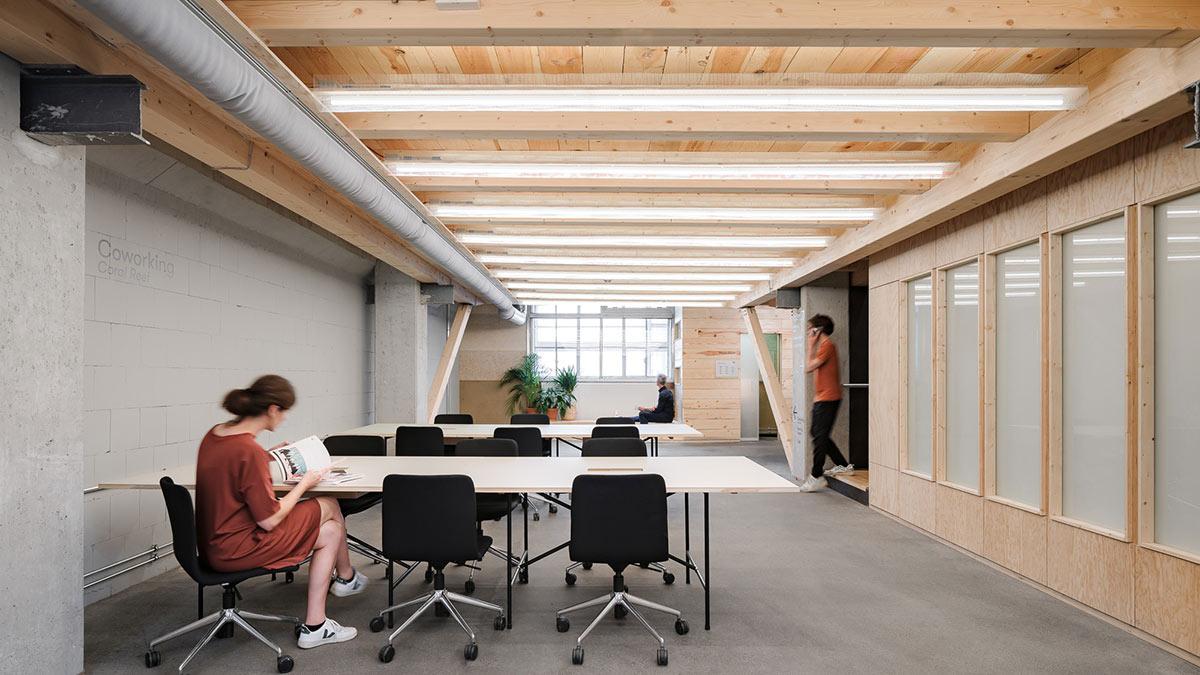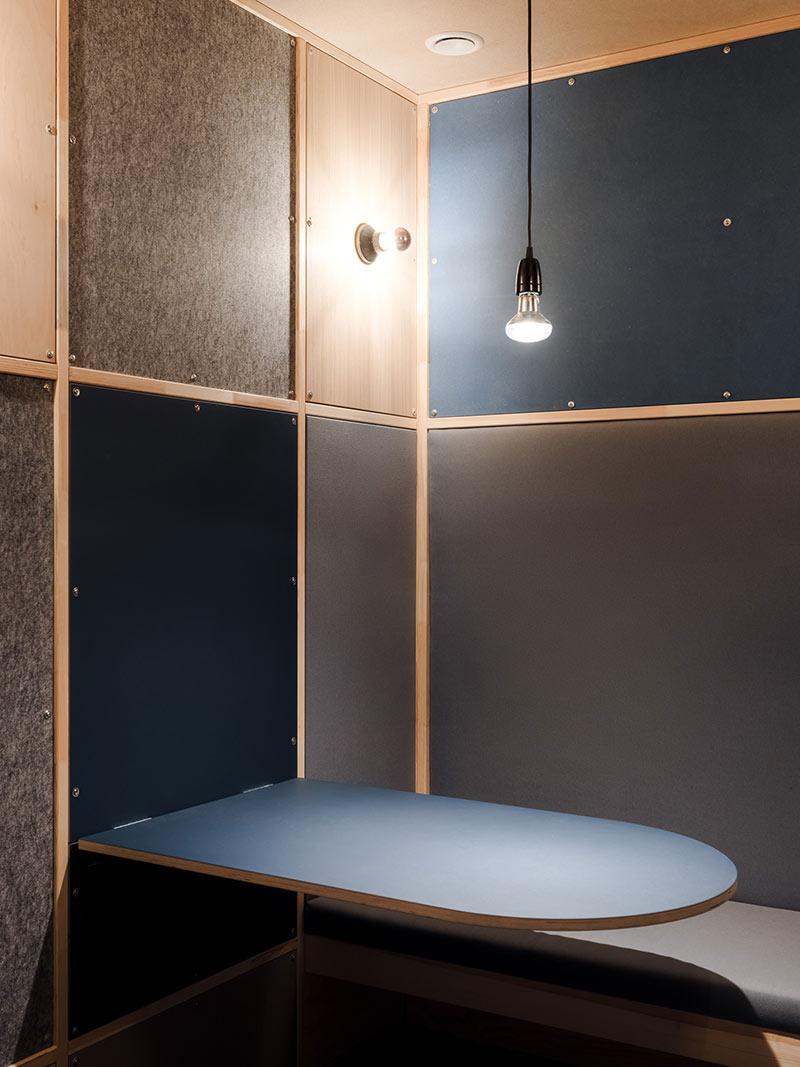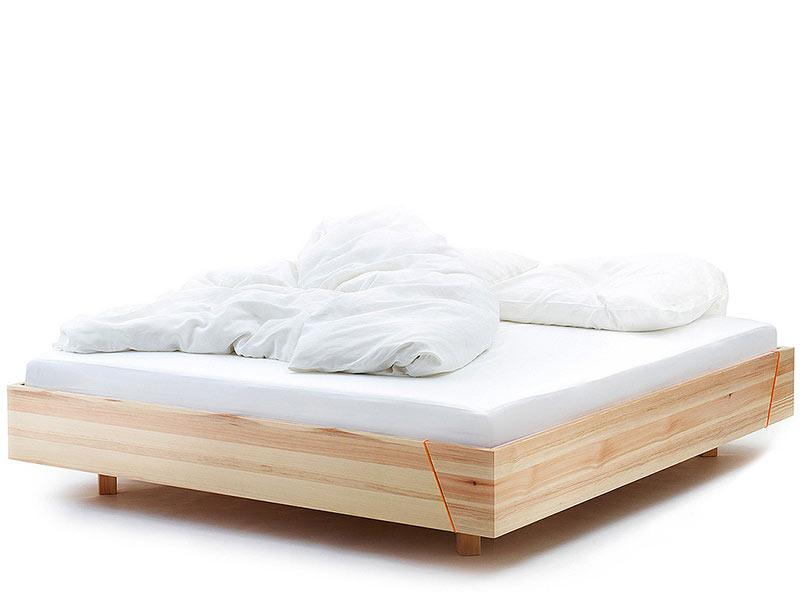The circular office
Impact Hub Berlin is a community and coworking space that has taken recyclable construction from theory to practice. LXSY Architekten used timber construction and recycled building materials for the interior design in a converted old warehouse.
The red MDF boards and bricks in the reception area were sourced from a different building site, and their colour makes this space recognizable as one of several places throughout the coworking hub where people can meet up. Wooden slats used to build the telephone boxes are all offcuts from various joiners. The corresponding felt panels for sound insulation are recycled, as is the grey upholstered furniture on the upper floor, which comes from a clearance in Charlottenburg. It was taken apart and screwed together with yellow furniture to create a new piece of comfy seating for the lounge area.
Material with a history
Almost everything in Impact Hub Berlin has its own story to tell. The history of the black MDF boards is especially illustrious: they came from the Boros Foundation art exhibition that was on show in the legendary Berlin club Berghain during the pandemic. Here, they have been given a second life as cupboard doors and wall panels.
Around 70 percent of the materials and products used are recycled or sustainable.
Kim Le Roux and Margit Sichrovsky, LXSY Architekten
Launched in 2022, this coworking and community space is situated in Berlin’s Neukölln district, in a warehouse formerly used by Kindl, a long-established brewery. What used to be industrial wasteland was transformed in a non-profit process that commenced in 2016. Years previously, construction work began on the Circular Economy House (CRCLR House) by the cooperative project developers TRNSFRM. Impact Hub Berlin became their chosen tenant.
The interior was fitted out by the team at LXSY Architekten, led by architects Kim Le Roux and Margit Sichrovsky. Subsequently, Impact Hub Berlin was named the biggest sustainable coworking space in Europe to be built according to circular standards. As the project description explains: “Around 70 percent of the materials and products used are recycled or sustainable.”
Not outwardly second-hand
Despite this approach, these re-use specialists have shown that it is still possible to create an interior design that looks high-grade and homogenous. “The aesthetics of a circular building should deliberately dispel any prejudices around second-hand design or the notion of inferior materials,” the architects’ statement reads.
The aesthetics of a circular building should deliberately dispel any prejudices around second-hand design or the notion of inferior materials.
Kim Le Roux and Margit Sichrovsky, LXSY Architekten
It is no wonder that the project has received multiple awards and was also nominated for the DAM Preis 2024. For the previous Impact Hub Berlin site, where LXSY Architekten were also responsible for the interior design, they were presented with the German Design Award 2017.
The architects say that reusing construction elements and materials needs good organization, but on the whole the time and trouble involved are the same as would otherwise be necessary for coordination with the right manufacturers. However, one thing is definitely different about a circular project of this kind, and that is the design process. This contrasts distinctly with conventional architecture planning procedures.
Design by availability
Instead of choosing specific materials for walls, doors and other structural components, the architects prepared descriptions of general qualities – such as if the materials needed to be opaque, translucent or transparent. When this work was completed, they set out to find the corresponding materials and store them near the building site. This concept is otherwise known as “design by availability”.
A network of local demolition and clearance firms helped them to track down reusable building materials, while a removals company regularly called on the city’s carpenters to collect wood cut-offs. Besides this, they worked with companies who specialize in the redistribution of old building materials, such as Trash Galore from Leipzig and Concular, which is itself headquartered at Impact Hub Berlin.
From installation to disassembly
In order to be able to reuse smaller pieces of material, the team developed a drywall installation concept that is based on the conventional timber construction grid of 62.5 cm. Nevertheless, the combination of different wall panels in a meeting booth appears anything but randomly thrown together. Wooden and felt panels alternate with black MDF boards to create a harmonious overall design.
In a nod to the history of the site, the industrial character of the existing building can still be felt.
Kim Le Roux and Margit Sichrovsky, LXSY Architekten
Circular construction is not just about recycling building materials. Rather, wherever possible the entire lifecycle of a material is reviewed, through to the very end. “Recyclable materials, deconstructable and unmixed constructions and simple standards are used for the interior fittings. With the help of product and material passports, the elements used can be repurposed after disassembly,” the architects explain.
New Work with industrial flair
The design envisaged the rather crude architecture of the former warehouse still being palpable even after the redevelopment. The existing grid of concrete pillars supplied the matrix for the new spatial structure, which is based on the “house-within-a-house” principle. Installation of a timber gallery divides the hub into two levels and offers fascinating views. As the architects remark: “In a nod to the history of the site, the industrial character of the existing building can still be felt.”
It goes without saying that the post-pandemic working atmosphere with its passion for New Work is reflected in the spatial design. In an interplay of communication and retreat, the office spaces are structured into a diverse range of work environments, chequered with chill-out areas, telephone boxes and little alcoves for power naps.
Serendipity creates innovation
The overall concept is designed to maximize chance meetings, which often result in new ideas. These encounters are called “serendipity moments”, which are known to have produced many famous discoveries such as X-rays or penicillin. It was this kind of random meeting that gave rise to the “Kiezbett”, which is produced by regional small companies as a sustainable, resource-friendly product that is delivered via cargo bike.
Both the bed and the hub’s interior design have a similar approach, however – instead of just talking about the circular economy, LXSY Architekten have simply rolled up their sleeves and gone ahead with their plan: “To make the world just a little bit better.”
Text: Gertraud Gerst
Translation: Rosemary Bridger-Lippe
Photos: Studio Bowie, Joris van Velzen
